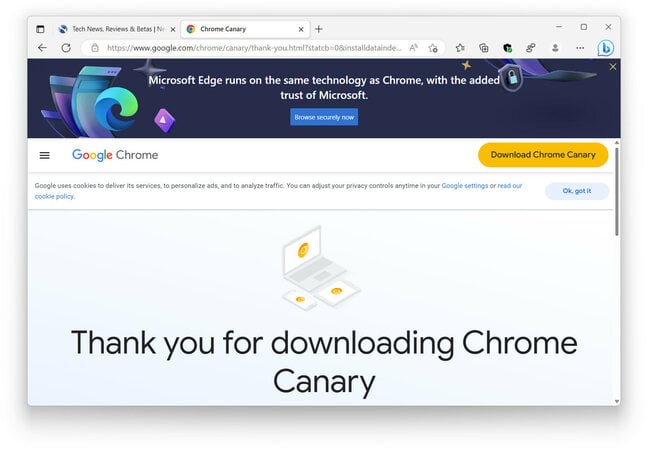Microsoft Edge has been spotted inserting a banner into the Chrome download page on Google.com begging people to stick with the Windows giant's browser.
As noted this week by Neowin, an attempt to download and install Chrome Canary using Edge Canary – both experimental browser builds – led to the presentation in the Edge browser window of a banner graphic celebrating the merits of Edge.

Screenshot of Edge injecting an anti-Chrome banner ad into Google.com's Chrome download page ... Source: Chris Frantz
"Microsoft Edge runs on the same technology as Chrome, with the added trust of Microsoft," the banner proclaims atop a button labeled "Browse securely now."
This was on a Google web page, google.com/chrome/canary/thank-you.html, and it's not clear how this ad surfaced. Edge appears to display the banner by itself when the user surfs to the Chrome download page on Google.com, which is just a little bit aggressive.
Microsoft did not immediately respond to a request to explain the promotion and the mechanics behind it.
The ad does not appear to have been delivered through normal ad servers based on its page placement. There's debate among those discussing the banner online whether the ad consists of code injected by Edge into Google's webpage, which would make it detectable and removable as part of the Document Object Model.
It has also been suggested that the ad may come from Edge as an interface element that's stacked atop the rendered web page. We believe this is the case.
An individual familiar with browser development confirmed to The Register that he could reproduce the ad, which was said to be written in HTML but wasn't placed "in" the page. He described the ad as its own browser window that, surprisingly, was viewable with Edge's "Inspect" option for viewing source code.
Our source speculated the ad was implemented in a way that pushes down the "Content area" – the space where loaded web pages get rendered – to make space for a second rendering area that holds the ad.
The main content area and the ad content area do not interact with each other – they exist in separate worlds, so to speak. But the presence of the ad content area can be inferred by checking the main window's innerHeight and outerHeight parameters.
Given two browser windows, one with the ad and one without, the main window with the ad will have an innerHeight value that's less than a similarly sized window without the ad. The difference in the two measurements should correspond to the height of the ad content area.
Similar behavior can be found when visiting the Chrome Web Store using Microsoft Edge on macOS: the Chrome Web Store page is topped by an Edge banner that states, "Now you can add extensions from the Chrome Web Store to Microsoft Edge," followed by a boxed button that says, "Allow extensions from other stores."
The button produces a popup dialog box requesting permission to allow browser extensions from other stores, specifically the Microsoft Edge add-ons site.
Crucially, this banner does not appear to be part of the Chrome Web Store page. It does not show up in the Chrome Web Store HTML code and, unlike the Chrome page ad, it cannot be inspected using Edge's developer tools. Similarly, the popup dialog box cannot be inspected. But the Chrome Web Store banner measures 45 pixels high based on a comparison of innerHeight parameters.
Among those who concern themselves with the nuances of browser behavior, it's argued that blurring the boundaries between what the browser presents and what the website presents is both confusing and a potential security risk.
As of Wednesday, Edge's self-promotion on the Chrome download page became more scarce and the ad now is said to appear only when trying to download Chrome using Edge Beta. Other Edge release channels Canary, Dev, and Stable reportedly no longer display the promotion.
Companies commonly pitch their own products on their own websites. And they often place ads on search results pages when people search for competitors' products. For example, entering the keywords "download Chrome" in macOS Edge, using Bing as the default search engine, presently produces a "Promoted by Microsoft" ad for Edge atop the Bing search results list. And searching "download Firefox" via Bing will lead to the same ad. But these ads exist within the context of the search result page.
Microsoft earlier this month introduced a new version of Bing that's paired with AI chatbot ChatGPT. The AI flavoring has also shown up in its Edge browser. Microsoft executives have made clear that they see AI service integration as a way to differentiate company products and to win market share from Google Search and Google Chrome.
Google's market dominance in search and browsers has for years been the subject of antitrust inquiries. These investigations and lawsuits, together with the implementation of the European Digital Markets Act, may finally open the door to Bing and Edge.
Microsoft has quite a bit of headroom for its search service and browser: Bing had about 3.03 percent of the global search market and Edge had about 4.6 percent of the global browser market, according to StatCounter. Now it just has to reconcile "the added trust of Microsoft" with its ad strategy. ®
https://news.google.com/rss/articles/CBMiRGh0dHBzOi8vd3d3LnRoZXJlZ2lzdGVyLmNvbS8yMDIzLzAyLzIzL21pY3Jvc29mdF9lZGdlX2Jhbm5lcl9jaHJvbWUv0gFIaHR0cHM6Ly93d3cudGhlcmVnaXN0ZXIuY29tL0FNUC8yMDIzLzAyLzIzL21pY3Jvc29mdF9lZGdlX2Jhbm5lcl9jaHJvbWUv?oc=5
2023-02-23 08:28:00Z
1797326779

Tidak ada komentar:
Posting Komentar